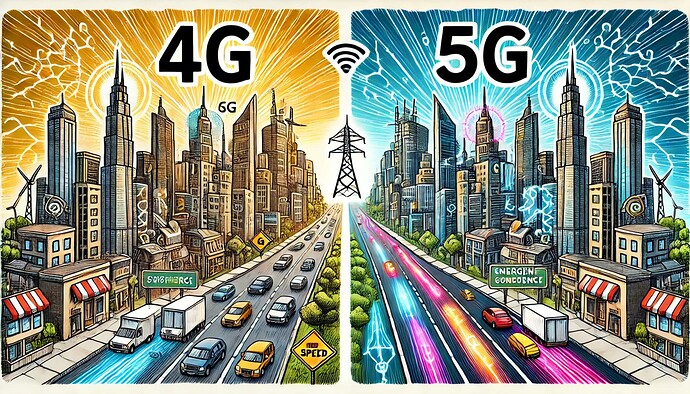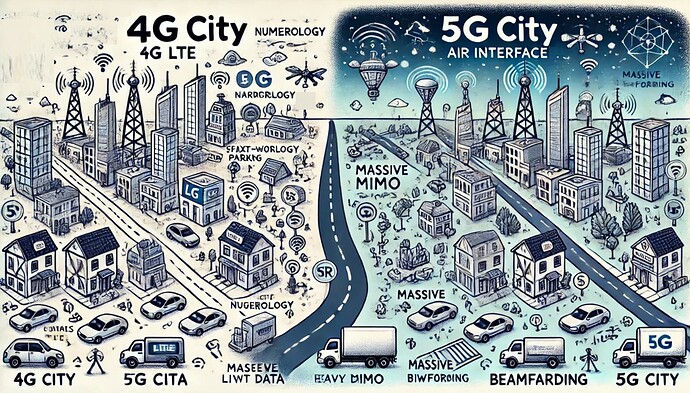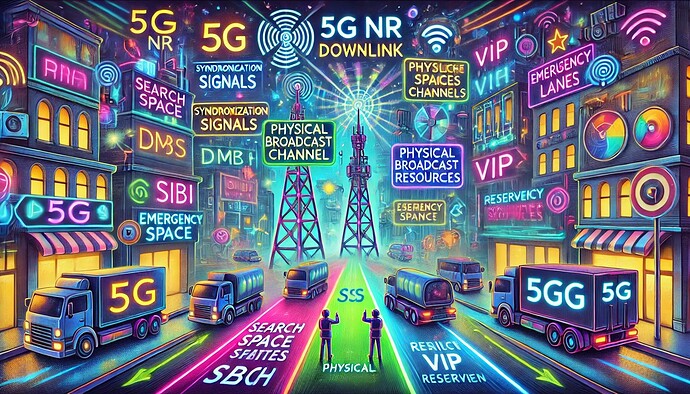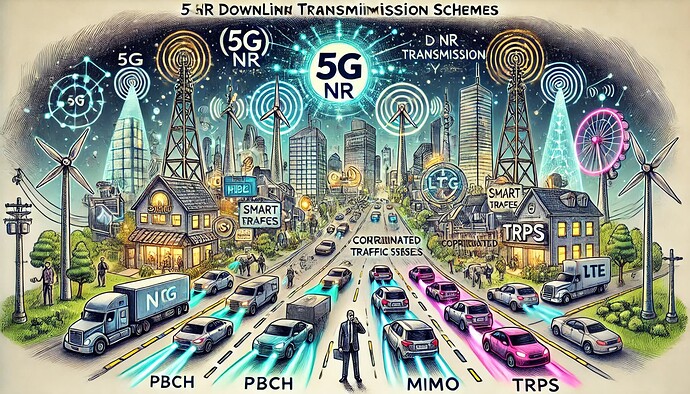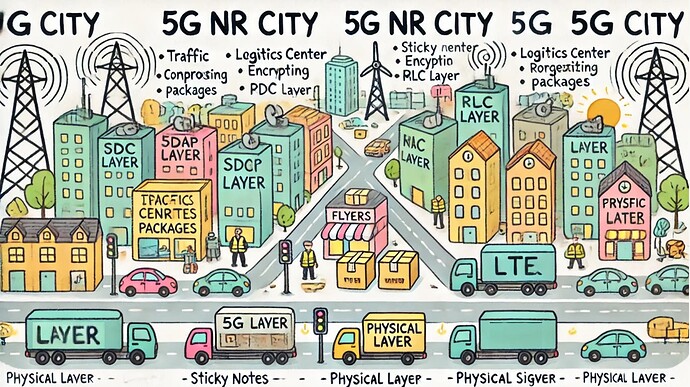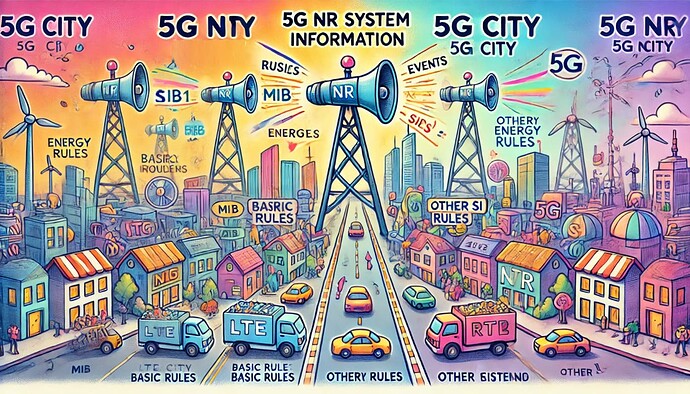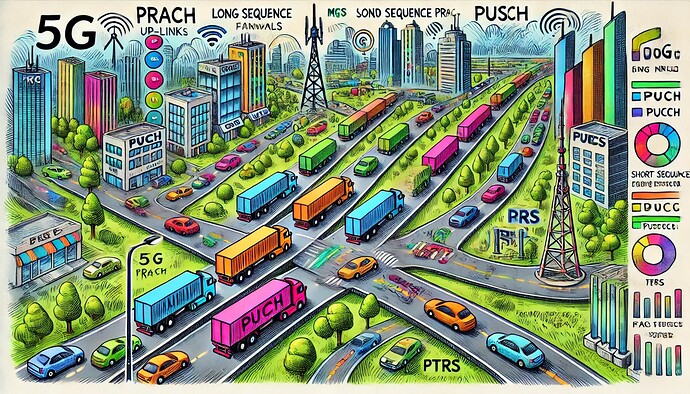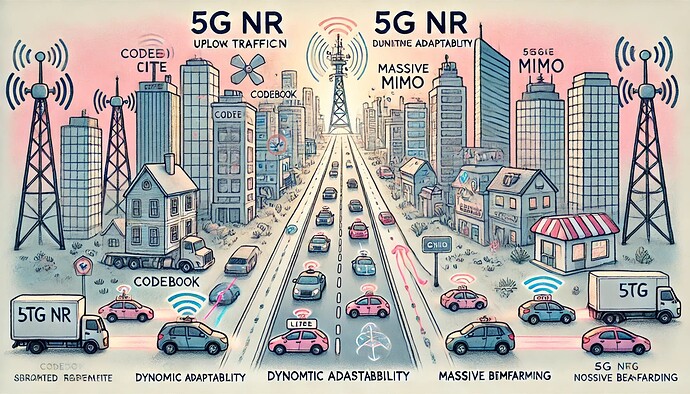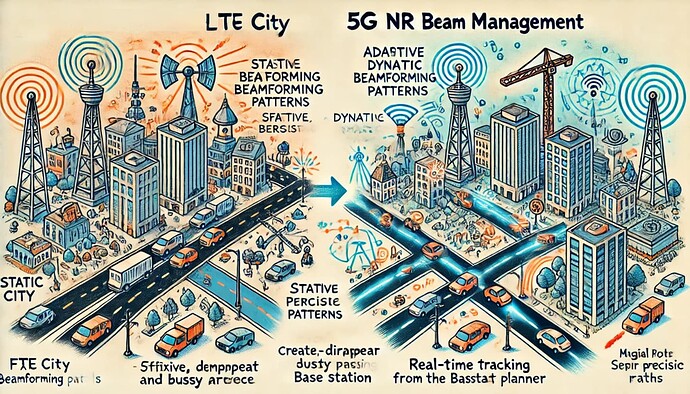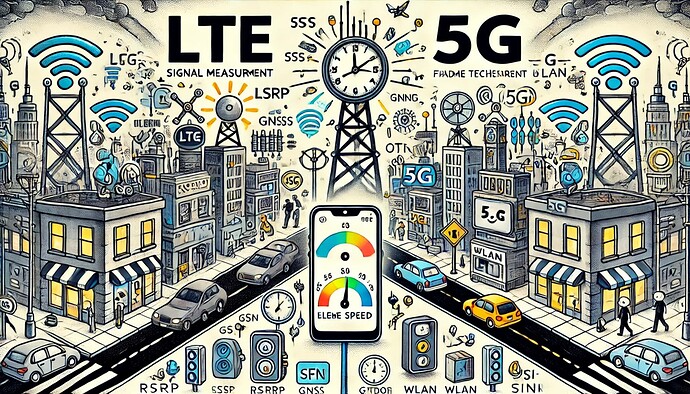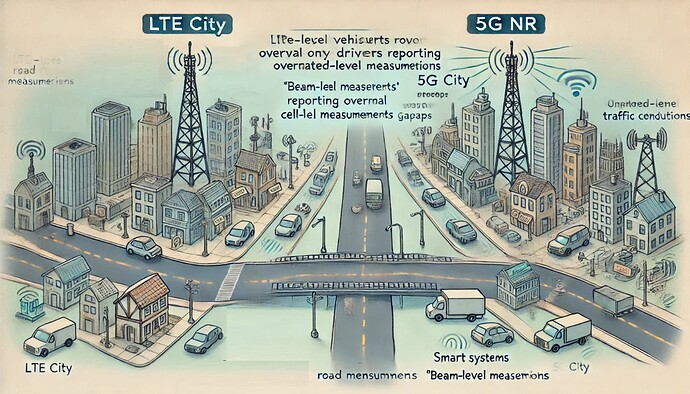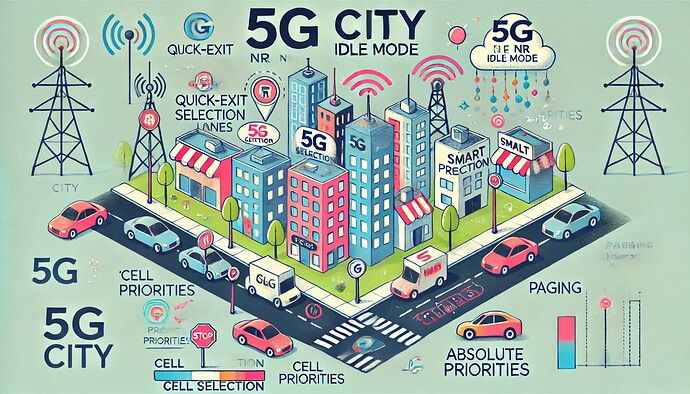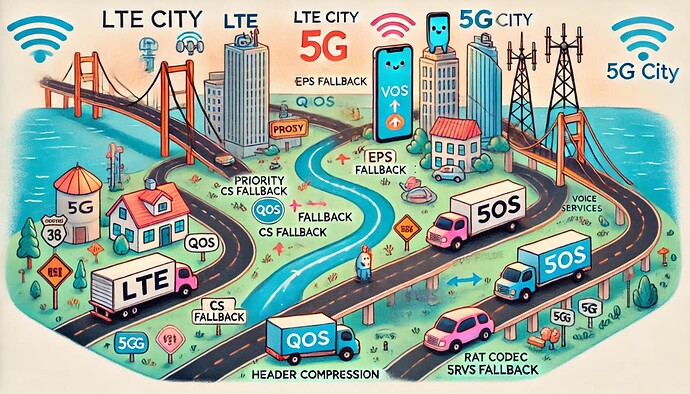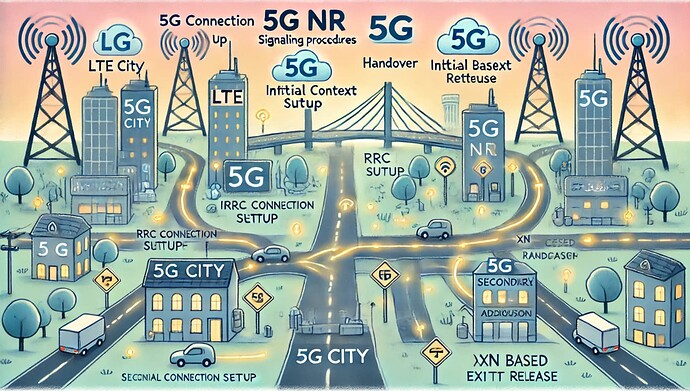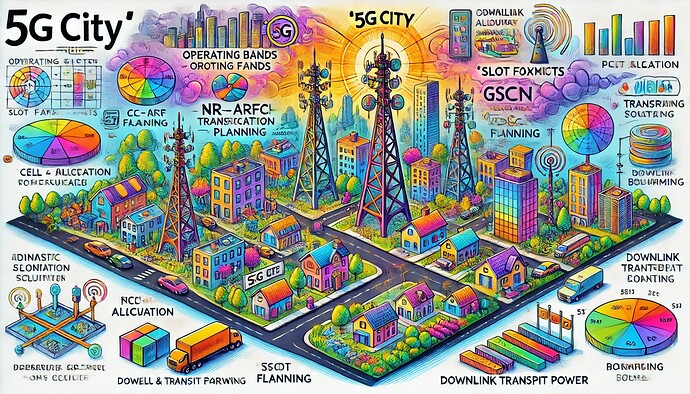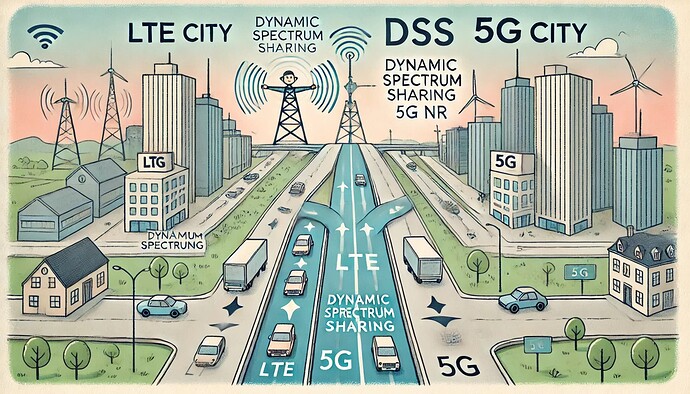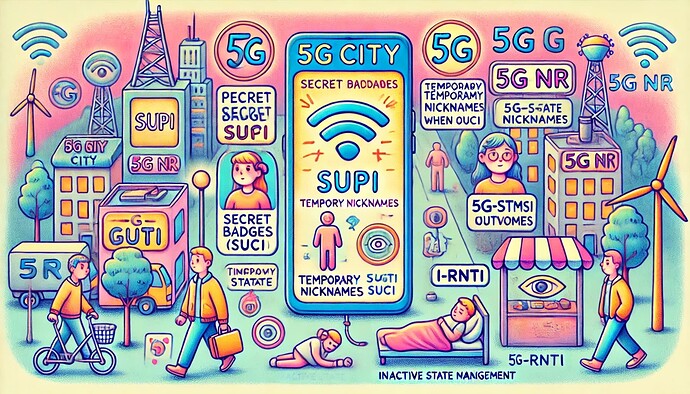This topic presents in a very simplified way all the main concepts that should be understood by those who know 5G NR.
Skip to: Roadmap
- Fundamentals
 sections
sections - Air Interface
 sections
sections - Downlink Signals and Channels
 sections
sections - Downlink Transmission Schemes
 sections
sections - Flow of Downlink Data
 sections
sections - System Information
 sections
sections - Uplink Signals and Channels
 sections
sections - Uplink Transmission Schemes
 sections
sections - Beam Management
 sections
sections - UE Measurements
 sections
sections - Measurement Reporting
 sections
sections - Idle Mode Procedures
 sections
sections - Physical and MAC Layer Procedures
 sections
sections - Voice Services
 sections
sections - Signalling Procedures
 sections
sections - Radio Network Planning
 sections
sections - Dynamic Spectrum Sharing
 sections
sections - UE Identities
 sections
sections
Fundamentals
5G, the new generation of mobile networks introduced in the 3GPP’s Release 15, is designed to meet three key demands: ultra-fast mobile internet (eMBB), highly reliable, low-latency communications (URLLC), and massive device connectivity (mMTC). While 4G relies on LTE, 5G operates on a network called New Radio (NR), designed to work alongside 4G in a configuration called Non-Standalone (NSA), allowing for a gradual transition. A full 5G setup, or Standalone (SA), connects directly to a new 5G core network, maximizing the speed and efficiency benefits of this new technology. 5G base stations are highly flexible, enabling varied deployments and the use of advanced antennas for enhanced range and capacity. The network uses a broader frequency range to manage congestion and support the high speeds promised by 5G, while also employing advanced technologies like beamforming and MIMO to optimize connections and improve coverage, especially in dense areas. [In a Nutshell: 5G offers faster internet, reliable communication, and connectivity for many devices, using new technology for better performance and coverage.]
![]() *Imagine that 4G is like an old city where people travel on narrow roads and have small buildings. It works fine, but as more people move in, it gets crowded and slow. Now, 5G is like building a brand-new city with wide highways, fast trains, and tall buildings that fit a lot of people. This new city, 5G, has special roads for super-fast cars (for internet), roads for emergency vehicles that need no traffic (for urgent messages), and lots of parking spaces for all the devices people have. At first, people from the old city (4G) can use parts of the new city (5G), but over time, everyone will be able to move fully into the new city and enjoy all its benefits. 5G’s special highways and smart buildings make everything work faster, so nobody has to wait, even if the city gets really busy. [In a Nutshell analogy: 5G is like a modern city with wide, fast roads and plenty of space, designed to keep everything running smoothly as more people use it.]
*Imagine that 4G is like an old city where people travel on narrow roads and have small buildings. It works fine, but as more people move in, it gets crowded and slow. Now, 5G is like building a brand-new city with wide highways, fast trains, and tall buildings that fit a lot of people. This new city, 5G, has special roads for super-fast cars (for internet), roads for emergency vehicles that need no traffic (for urgent messages), and lots of parking spaces for all the devices people have. At first, people from the old city (4G) can use parts of the new city (5G), but over time, everyone will be able to move fully into the new city and enjoy all its benefits. 5G’s special highways and smart buildings make everything work faster, so nobody has to wait, even if the city gets really busy. [In a Nutshell analogy: 5G is like a modern city with wide, fast roads and plenty of space, designed to keep everything running smoothly as more people use it.]
Air Interface
The 5G NR air interface introduces significant advancements over LTE, offering greater flexibility, efficiency, and speed. It introduces numerology, which allows multiple subcarrier spacing options (15 to 240 kHz) for better adaptation to different frequencies and use cases. Bandwidth Parts (BWPs) divide the spectrum into smaller segments, optimizing resource use and power efficiency, while Resource Blocks (RBs) and Physical Resource Blocks (PRBs) dynamically adapt to changing conditions. Wider bandwidths (up to 400 MHz in mmWave) and a more flexible frequency raster enable faster speeds and higher capacity. New features like synchronization raster speed up initial connections, and enhanced waveforms like CP-OFDM and DFT-S-OFDM improve consistency and power efficiency. Additionally, the transmitter and receiver chain (Tx/Rx chain), with technologies like massive MIMO and beamforming, supports higher data rates, wider bandwidths, and complex signal processing. Altogether, 5G NR enables faster, more reliable, and efficient wireless communication tailored to diverse applications and devices. [In a Nutshell: 5G NR air interface improves speed, reliability, and flexibility, using advanced technologies like numerology, BWPs, and massive MIMO.]
![]() Imagine LTE City as a small, simple town with fixed-width roads and parking spots, where cars (data) follow strict schedules and landmarks (signals) are always in the same place, making it predictable but slow when traffic gets heavy. Now, think of 5G City as a futuristic metropolis with roads that can change size to fit small cars or big trucks, smart parking zones that adapt to save space, and ultra-fast highways and bike lanes for efficient traffic flow. Landmarks are spread across the city for quicker navigation, and flying delivery drones (massive MIMO and beamforming) bypass busy roads to deliver packages directly. This futuristic design allows 5G City to handle way more traffic, move things faster, and ensure everyone gets where they need to go smoothly and efficiently. [In a Nutshell: 5G City’s smart, flexible roads and futuristic upgrades handle more traffic and deliver faster, unlike LTE City’s fixed and slower system.]
Imagine LTE City as a small, simple town with fixed-width roads and parking spots, where cars (data) follow strict schedules and landmarks (signals) are always in the same place, making it predictable but slow when traffic gets heavy. Now, think of 5G City as a futuristic metropolis with roads that can change size to fit small cars or big trucks, smart parking zones that adapt to save space, and ultra-fast highways and bike lanes for efficient traffic flow. Landmarks are spread across the city for quicker navigation, and flying delivery drones (massive MIMO and beamforming) bypass busy roads to deliver packages directly. This futuristic design allows 5G City to handle way more traffic, move things faster, and ensure everyone gets where they need to go smoothly and efficiently. [In a Nutshell: 5G City’s smart, flexible roads and futuristic upgrades handle more traffic and deliver faster, unlike LTE City’s fixed and slower system.]
Downlink Signals and Channels
5G NR downlink signals and channels enable efficient communication by organizing and transmitting various types of data from the network to devices. Downlink Channel Mappings ensure that user data, control instructions, and system information are categorized and routed effectively. Key components like Synchronization Signals (SS) and the Physical Broadcast Channel (PBCH) help devices detect the network and establish a connection using combined structures called SS/PBCH Blocks and Bursts. The Physical Downlink Control Channel (PDCCH) sends essential instructions about resource allocation and scheduling, managed within a configurable area called the CORESET (Control Resource Set). Search Space Sets (SSS) help devices locate control signals, including critical information like the System Information Block 1 (SIB1). Data is delivered through the Physical Downlink Shared Channel (PDSCH), optimized with advanced features like Modulation and Coding Scheme (MCS) and dynamic Transport Block Size (TBS) calculations. Supporting these functions are various Reference Signals (RS), such as DMRS (Demodulation Reference Signals) for accurate decoding, and CSI-RS (Channel State Information Reference Signals) for channel quality assessment. Additionally, features like Pre-emption, Reserved Resources, and Repetition ensure reliability and prioritization for critical communications, making 5G far more flexible, efficient, and capable than LTE. [In a Nutshell: 5G organizes, prioritizes, and delivers data more flexibly and efficiently than LTE, ensuring reliability and scalability.]
![]() The city of 5G is a smarter, faster upgrade from the city of LTE, with better organization and advanced traffic systems. In 5G, Synchronization Signals (SS) act as welcome lights, helping devices find their way, while the PBCH (Physical Broadcast Channel) is like a digital map showing city rules, now combined in SS/PBCH Blocks and Bursts for efficiency. PDCCH (Physical Downlink Control Channel) is like traffic officers directing trucks (data) to their destinations, working flexibly in areas called CORESET (Control Resource Set). Devices find instructions in Search Space Sets (SSS), including special help desks like SIB1 Search Space for new visitors. Data is delivered by bigger, faster trucks on the PDSCH (Physical Downlink Shared Channel), optimized by smarter cargo systems like MCS and TBS. To keep things on track, 5G uses advanced markers like DMRS and updates like CSI-RS, while features like Pre-emption and Reserved Resources ensure emergency lanes and VIP routes for critical services. It’s a futuristic city built to handle more traffic and complexity than LTE ever could. [In a Nutshell: 5G is like a futuristic city with smarter traffic systems, ensuring faster and more reliable communication than LTE.]
The city of 5G is a smarter, faster upgrade from the city of LTE, with better organization and advanced traffic systems. In 5G, Synchronization Signals (SS) act as welcome lights, helping devices find their way, while the PBCH (Physical Broadcast Channel) is like a digital map showing city rules, now combined in SS/PBCH Blocks and Bursts for efficiency. PDCCH (Physical Downlink Control Channel) is like traffic officers directing trucks (data) to their destinations, working flexibly in areas called CORESET (Control Resource Set). Devices find instructions in Search Space Sets (SSS), including special help desks like SIB1 Search Space for new visitors. Data is delivered by bigger, faster trucks on the PDSCH (Physical Downlink Shared Channel), optimized by smarter cargo systems like MCS and TBS. To keep things on track, 5G uses advanced markers like DMRS and updates like CSI-RS, while features like Pre-emption and Reserved Resources ensure emergency lanes and VIP routes for critical services. It’s a futuristic city built to handle more traffic and complexity than LTE ever could. [In a Nutshell: 5G is like a futuristic city with smarter traffic systems, ensuring faster and more reliable communication than LTE.]
Downlink Transmission Schemes
5G NR significantly improves downlink transmission schemes compared to LTE by enhancing efficiency, reliability, and adaptability. The PBCH simplifies device connections with a single antenna port and beamforming for better coverage. The PDCCH introduces CORESET for dynamic control signal placement, improving flexibility in high-density environments. The PDSCH supports up to 8 transmission layers and advanced features for faster, more reliable data delivery. MIMO techniques are more advanced in 5G, with Open Loop MIMO offering better reliability, Semi-Open Loop MIMO balancing limited feedback with precision, and Closed Loop MIMO using detailed feedback for optimized transmissions. Multi-User MIMO (MU-MIMO) increases efficiency by allowing multiple devices to share resources via spatial separation. Reciprocity-based transmission optimizes downlink performance using uplink measurements, reducing overhead. Lastly, Multiple Transmit and Receive Point (TRP) schemes improve performance at cell edges, leveraging coordinated transmission strategies. These advancements make 5G NR far superior to LTE, addressing modern connectivity demands more effectively. [In a Nutshell: 5G NR improves efficiency, reliability, and adaptability compared to LTE with smarter tools and advanced features.]
![]() In LTE’s city, everything was a bit slower and less organized - there were fixed traffic officers, smaller delivery trucks, and fewer tools to handle busy roads. In 5G’s city, it’s like they’ve built a super-smart traffic system! There’s a big welcome board with spotlights (PBCH) that quickly shows new visitors where to go. Traffic officers (PDCCH) can move around and use megaphones to guide cars better. Delivery trucks (PDSCH) are bigger and faster, with smart GPS tools to find the best routes, even in traffic jams. The highways now let multiple cars share the same lane (MU-MIMO), with advanced signals to keep everything smooth. Sensors on outgoing cars (reciprocity-based) help manage incoming traffic, and multiple traffic towers (TRPs) work together at the city’s edges to make sure no one gets lost. It’s like the ultimate upgrade - faster, smarter, and ready for more! [In a Nutshell: 5G’s city has a smarter traffic system, with dynamic tools for faster, smoother, and more reliable connections than LTE.]
In LTE’s city, everything was a bit slower and less organized - there were fixed traffic officers, smaller delivery trucks, and fewer tools to handle busy roads. In 5G’s city, it’s like they’ve built a super-smart traffic system! There’s a big welcome board with spotlights (PBCH) that quickly shows new visitors where to go. Traffic officers (PDCCH) can move around and use megaphones to guide cars better. Delivery trucks (PDSCH) are bigger and faster, with smart GPS tools to find the best routes, even in traffic jams. The highways now let multiple cars share the same lane (MU-MIMO), with advanced signals to keep everything smooth. Sensors on outgoing cars (reciprocity-based) help manage incoming traffic, and multiple traffic towers (TRPs) work together at the city’s edges to make sure no one gets lost. It’s like the ultimate upgrade - faster, smarter, and ready for more! [In a Nutshell: 5G’s city has a smarter traffic system, with dynamic tools for faster, smoother, and more reliable connections than LTE.]
Flow of Downlink Data
In 5G NR, the flow of downlink data begins with the SDAP Layer, which acts like traffic control, ensuring each type of data (like video calls or downloads) gets the right priority for smooth delivery. Next, the PDCP Layer compresses the data to save space, encrypts it for security, and ensures everything is in the correct order before moving forward. The RLC Layer works as a sorting facility, breaking data into smaller pieces and reassembling it at the destination. Depending on the need, it operates in Transparent Mode (TM) for quick control messages, Unacknowledged Mode (UM) for speedy delivery without confirmation (like live streaming), or Acknowledged Mode (AM) for reliable delivery with retransmissions (like file transfers). Finally, the MAC Layer acts as a distribution center, organizing the data for efficient scheduling and transmission, using smarter systems in 5G NR to handle higher speeds and wider frequencies. Together, these layers ensure data flows efficiently, securely, and reliably in 5G NR, far exceeding what LTE could achieve. [In a Nutshell: 5G NR’s data flow uses smarter layers to prioritize, secure, and efficiently deliver data, surpassing LTE.]
![]() In LTE City, packages (data) were delivered, but the system wasn’t very organized. There was no traffic police to prioritize important deliveries, the sorting centers sometimes couldn’t handle everything quickly, and the delivery routes weren’t very flexible. In the upgraded 5G NR City, everything is much smarter and faster. First, there’s a team of traffic police (SDAP Layer) that makes sure important deliveries, like ambulances (video calls), get priority lanes, while trucks (downloads) use their own routes to avoid traffic. Next, the PDCP Center compresses the packages so they’re easier to carry, locks them up safely (encryption), and puts them in the right order so nothing gets mixed up. Then, the RLC Sorting Facility cuts big packages into smaller pieces and decides how to handle them: sticky notes without envelopes (TM) for simple messages, flyers tossed in the wind (UM) for fast deliveries, or courier deliveries (AM) for important packages that need to arrive perfectly. Finally, all the packages go to the Distribution Center (MAC Layer), where they are put into boxes and loaded onto delivery trucks. The trucks then leave through the shipping docks (Physical Layer) and travel smoothly to their destinations, thanks to smart traffic lights (Physical Signals) guiding them. In 5G NR City, everything runs faster, more securely, and more efficiently than in LTE City! [In a Nutshell: In 5G NR City, smarter systems prioritize, sort, and deliver packages faster and more efficiently than LTE City.]
In LTE City, packages (data) were delivered, but the system wasn’t very organized. There was no traffic police to prioritize important deliveries, the sorting centers sometimes couldn’t handle everything quickly, and the delivery routes weren’t very flexible. In the upgraded 5G NR City, everything is much smarter and faster. First, there’s a team of traffic police (SDAP Layer) that makes sure important deliveries, like ambulances (video calls), get priority lanes, while trucks (downloads) use their own routes to avoid traffic. Next, the PDCP Center compresses the packages so they’re easier to carry, locks them up safely (encryption), and puts them in the right order so nothing gets mixed up. Then, the RLC Sorting Facility cuts big packages into smaller pieces and decides how to handle them: sticky notes without envelopes (TM) for simple messages, flyers tossed in the wind (UM) for fast deliveries, or courier deliveries (AM) for important packages that need to arrive perfectly. Finally, all the packages go to the Distribution Center (MAC Layer), where they are put into boxes and loaded onto delivery trucks. The trucks then leave through the shipping docks (Physical Layer) and travel smoothly to their destinations, thanks to smart traffic lights (Physical Signals) guiding them. In 5G NR City, everything runs faster, more securely, and more efficiently than in LTE City! [In a Nutshell: In 5G NR City, smarter systems prioritize, sort, and deliver packages faster and more efficiently than LTE City.]
System Information
5G NR System Information is a set of essential messages broadcast by the network to help devices connect and communicate effectively. These messages include critical details such as network configuration, cell access rules, and mobility settings. While components like the Master Information Block (MIB) and System Information Blocks (SIBs) were carried over from LTE, 5G enhances them for faster and more efficient communication. Unlike LTE, where system information like MIB, SIB1, and SIB2 is broadcast periodically across the entire cell - even when no devices are present - causing energy waste and unnecessary signaling overhead, 5G NR uses a smarter approach. It divides system information into two categories: Minimum SI and Other SI. Minimum SI, which includes MIB and SIB1, provides the basic information needed for devices to access the network. Other SI offers additional details but is only transmitted when explicitly requested by devices. This on-demand approach reduces energy consumption and signaling overhead, making 5G NR more efficient and better suited to modern network needs, such as higher speeds and lower latency. [In a Nutshell: 5G NR builds on LTE with smarter, more efficient system information handling that saves energy and reduces overhead.]
![]() In LTE City, there’s a big speaker system that constantly announces all the city’s information - like the rules, events, and maps - even if no one is around to listen. This wastes energy and keeps running all the time. But in 5G NR City, the speaker system is smarter. It only announces the most important information, like the city’s basic rules (MIB and SIB1), so newcomers know how to get started. If someone needs extra details, like where the best restaurants or parks are, they can press a button and request it, and the speaker will share it only when needed. This way, 5G NR City saves energy and works more efficiently, helping everyone get what they need faster without unnecessary noise. [In a Nutshell: 5G NR City uses a smarter speaker system to share only necessary information, saving energy and improving efficiency.]
In LTE City, there’s a big speaker system that constantly announces all the city’s information - like the rules, events, and maps - even if no one is around to listen. This wastes energy and keeps running all the time. But in 5G NR City, the speaker system is smarter. It only announces the most important information, like the city’s basic rules (MIB and SIB1), so newcomers know how to get started. If someone needs extra details, like where the best restaurants or parks are, they can press a button and request it, and the speaker will share it only when needed. This way, 5G NR City saves energy and works more efficiently, helping everyone get what they need faster without unnecessary noise. [In a Nutshell: 5G NR City uses a smarter speaker system to share only necessary information, saving energy and improving efficiency.]
Uplink Signals and Channels
5G NR uplink signals and channels enable efficient and reliable communication from devices to the network by utilizing a variety of specialized features. Uplink Channel Mappings categorize data flows into logical, transport, and physical channels for seamless processing. The PRACH (Physical Random Access Channel) facilitates initial connections, with Long Sequence PRACH Formats optimized for rural coverage and Short Sequence PRACH Formats tailored for high-frequency, urban deployments. PUCCH (Physical Uplink Control Channel) handles control information like acknowledgments and scheduling requests, offering five formats (Format 0–4) for different payload sizes and durations, with PUCCH Repetition enhancing reliability under poor conditions. PUSCH (Physical Uplink Shared Channel) is the main channel for sending user data, with its efficiency boosted by features like Modulation and Coding Scheme (MCS) for adaptive signal quality, Transport Block Size (TBS) for optimized data packet sizes, and advanced Physical Layer Processing for error correction and resource utilization. Resource Allocations ensure fair and efficient use of frequency and time resources through dynamic or preconfigured grants. Supporting signals include Uplink Reference Signals like DMRS-PUSCH and DMRS-PUCCH for decoding data accurately, SRS (Sounding Reference Signal) for assessing channel conditions, and PTRS (Phase Tracking Reference Signal) for correcting phase noise at high frequencies. Together, these elements ensure fast, adaptive, and reliable communication across a variety of scenarios, from dense urban environments to high-speed rural connections. Compared to LTE, 5G NR significantly enhances these features, introducing innovations like Short Sequence PRACH Formats and PTRS, enabling higher efficiency, better scalability, and reliable performance in complex and high-frequency scenarios. [In a Nutshell: 5G NR uplink channels and signals work together to provide efficient and reliable device-to-network communication, tailored for various environments and use cases.]
![]() In the world of 5G and LTE cities, uplink signals and channels are the lifelines connecting devices (cars) to the city’s hub (the network). LTE City had efficient roads, but 5G City upgrades to smarter highways, advanced traffic systems, and faster deliveries. Entry begins with the PRACH doorbell (Physical Random Access Channel), with Long Sequence PRACH Formats for rural neighborhoods and Short Sequence PRACH Formats for busy urban areas. Cars delivering updates use PUCCH highways (Physical Uplink Control Channel), choosing one of five lanes (Formats 0–4) depending on message size and urgency, sometimes repeating messages (PUCCH Repetition) in tough conditions. Larger deliveries take the PUSCH superhighway (Physical Uplink Shared Channel), where MCS rules set cargo limits, TBS ensures efficient packing, and Physical Layer Processing protects cargo en route. Smart traffic lights (Resource Allocations) guide cars, while DMRS street markers (Demodulation Reference Signals) keep them on track. SRS echoes (Sounding Reference Signals) assess road conditions for future traffic, and PTRS steering systems (Phase Tracking Reference Signals) ensure smooth navigation on high-speed, mmWave roads. These systems work together in 5G City, enabling fast, safe, and efficient deliveries, even in the busiest or most remote areas. [In a Nutshell: 5G City’s advanced uplink system ensures smart, efficient, and reliable data delivery across a modern communication landscape.]
In the world of 5G and LTE cities, uplink signals and channels are the lifelines connecting devices (cars) to the city’s hub (the network). LTE City had efficient roads, but 5G City upgrades to smarter highways, advanced traffic systems, and faster deliveries. Entry begins with the PRACH doorbell (Physical Random Access Channel), with Long Sequence PRACH Formats for rural neighborhoods and Short Sequence PRACH Formats for busy urban areas. Cars delivering updates use PUCCH highways (Physical Uplink Control Channel), choosing one of five lanes (Formats 0–4) depending on message size and urgency, sometimes repeating messages (PUCCH Repetition) in tough conditions. Larger deliveries take the PUSCH superhighway (Physical Uplink Shared Channel), where MCS rules set cargo limits, TBS ensures efficient packing, and Physical Layer Processing protects cargo en route. Smart traffic lights (Resource Allocations) guide cars, while DMRS street markers (Demodulation Reference Signals) keep them on track. SRS echoes (Sounding Reference Signals) assess road conditions for future traffic, and PTRS steering systems (Phase Tracking Reference Signals) ensure smooth navigation on high-speed, mmWave roads. These systems work together in 5G City, enabling fast, safe, and efficient deliveries, even in the busiest or most remote areas. [In a Nutshell: 5G City’s advanced uplink system ensures smart, efficient, and reliable data delivery across a modern communication landscape.]
Uplink Transmission Schemes
In 5G NR, uplink transmission schemes ensure devices communicate efficiently with the base station (gNB). A codebook acts like a predefined guide with transmission patterns that help optimize signal delivery, supporting advanced technologies like massive MIMO and beamforming. Codebook-based transmission uses these predefined patterns, with the gNB providing feedback to select the best option, ensuring strong and reliable signals - an improved version of what existed in LTE. On the other hand, non-codebook-based transmission is a new feature in 5G NR, allowing devices to adapt in real-time by measuring channel conditions and dynamically choosing the best transmission strategy, making it ideal for complex environments without relying on predefined patterns. Together, these schemes make uplink communication in 5G NR smarter, faster, and more adaptable than ever before. [In a Nutshell: Uplink schemes in 5G NR use codebooks and dynamic adaptability to ensure faster, smarter, and more reliable communication.]
![]() Imagine two cities: LTE City and 5G NR City. In LTE City, drivers (devices) use old paper maps (codebooks) to find their way to the control tower (base station), but these maps can’t handle new highways or heavy traffic. In 5G NR City, the maps are upgraded and smarter, showing the fastest routes, including big new highways like massive MIMO, and the control tower (gNB) gives live updates to guide drivers - this is codebook-based transmission. Even cooler, in 5G NR City, some drivers don’t need maps at all; they have super-smart cars that look at traffic and road conditions in real-time to find their own way - this is non-codebook-based transmission, perfect for tricky areas. Together, these methods make sure every driver in 5G NR City gets to their destination faster and more smoothly than in LTE City! [In a Nutshell: In the 5G NR City, smarter maps and self-driving cars make traffic flow faster and more efficiently than in LTE City.]
Imagine two cities: LTE City and 5G NR City. In LTE City, drivers (devices) use old paper maps (codebooks) to find their way to the control tower (base station), but these maps can’t handle new highways or heavy traffic. In 5G NR City, the maps are upgraded and smarter, showing the fastest routes, including big new highways like massive MIMO, and the control tower (gNB) gives live updates to guide drivers - this is codebook-based transmission. Even cooler, in 5G NR City, some drivers don’t need maps at all; they have super-smart cars that look at traffic and road conditions in real-time to find their own way - this is non-codebook-based transmission, perfect for tricky areas. Together, these methods make sure every driver in 5G NR City gets to their destination faster and more smoothly than in LTE City! [In a Nutshell: In the 5G NR City, smarter maps and self-driving cars make traffic flow faster and more efficiently than in LTE City.]
Beam Management
Beam Management in 5G is crucial for optimizing signal transmission in both uplink and downlink directions. It involves selecting and maintaining the best beams for communication, tailored to specific deployment scenarios. Higher frequencies (Frequency Range 2) utilize advanced antenna panels for precise beamforming, while lower frequencies (Frequency Range 1) often use simpler setups. Beam Management progresses through stages: broad initial beam acquisition, refinement to high-gain directional beams for improved performance, and mobility management for seamless transitions between beams during movement. Downlink beam selection uses signals like SS/PBCH Blocks and CSI Reference Signals, while uplink beams rely on Sounding Reference Signals (SRS). Specialized configurations handle cases where uplink and downlink beams differ, ensuring efficiency. These processes occur at lower network layers to avoid interruptions, enhancing data transmission. Key procedures include initial beam selection (P-1), refinement (P-2), and optimization (P-3) to maintain reliable, high-quality connections. While LTE supports beamforming, particularly in the downlink, its beam management is less advanced than 5G NR. LTE uses fixed beamforming patterns that are less adaptive, whereas 5G NR features dynamic beam selection, tracking, and user-specific beamforming, achieving better data rates, coverage, and lower latency in challenging environments. [In a Nutshell: Beam Management ensures optimal signal paths for 5G, offering better adaptability and performance than LTE.]
![]() Imagine LTE and 5G as two cities where people travel on roads to get where they need to go. In the LTE City, the roads are fixed, like permanent highways, and cars must follow pre-set routes no matter how crowded or inefficient they are. The traffic flows okay most of the time, but if there’s a lot of congestion or a roadblock, there’s no easy way to fix it. On the other hand, the 5G City has magical roads that can appear and disappear as needed. If traffic builds up or someone needs a quicker route, the roads shift direction or create new paths instantly. In 5G City, some areas with lots of traffic use advanced tools to make super-precise, direct paths, while quieter neighborhoods stick to simpler setups. The system also tracks every car in real time, making sure travelers switch smoothly between roads if they move to a different part of the city. This makes 5G City faster, more reliable, and better at handling challenges than LTE City, where the roads don’t adapt. [In a Nutshell: LTE is like a city with fixed roads, while 5G has magical, dynamic roads that adapt to traffic and challenges in real-time.]
Imagine LTE and 5G as two cities where people travel on roads to get where they need to go. In the LTE City, the roads are fixed, like permanent highways, and cars must follow pre-set routes no matter how crowded or inefficient they are. The traffic flows okay most of the time, but if there’s a lot of congestion or a roadblock, there’s no easy way to fix it. On the other hand, the 5G City has magical roads that can appear and disappear as needed. If traffic builds up or someone needs a quicker route, the roads shift direction or create new paths instantly. In 5G City, some areas with lots of traffic use advanced tools to make super-precise, direct paths, while quieter neighborhoods stick to simpler setups. The system also tracks every car in real time, making sure travelers switch smoothly between roads if they move to a different part of the city. This makes 5G City faster, more reliable, and better at handling challenges than LTE City, where the roads don’t adapt. [In a Nutshell: LTE is like a city with fixed roads, while 5G has magical, dynamic roads that adapt to traffic and challenges in real-time.]
UE Measurements
5G NR UE Measurements are measurements used by devices to evaluate the network’s signal strength, quality, and performance, ensuring reliable connections and efficient mobility. Measurements like SS-RSRP and SS-RSRQ assess signal power and quality, helping devices select the best cell and manage movement between cells, while SS-SINR focuses on signal clarity by comparing it to interference and noise. Advanced measurements like CSI-RSRP, CSI-RSRQ, and CSI-SINR provide similar insights but are specifically tailored for managing directional beams and high-speed mobility, essential in 5G’s beam-based architecture. Additional capabilities, such as SFN and Frame Timing Difference (SFTD), synchronize 4G and 5G networks for seamless operation in mixed environments, and other measurements, like those for positioning (GNSS, OTDOA, and WLAN), support precise location tracking. Together, these measurements enable 5G to deliver faster, more reliable, and smarter connectivity than previous networks. [In a Nutshell: 5G UE Measurements assess signal strength, quality, and performance, ensuring smooth mobility, beam management, synchronization, and accurate positioning.]
![]() Imagine LTE and 5G as two cities: LTE City is good and reliable, with streetlights (RSRP) showing how strong the signal is and signs (RSRQ) telling how noisy it is, helping your phone pick the best neighborhood. 5G City, however, is faster and smarter, with brighter streetlights (SS-RSRP), clearer signs (SS-RSRQ), and radio detectors (SS-SINR) to find the cleanest path. For speedy travelers (your phone), 5G City adds special beam markers (CSI-RSRP, CSI-RSRQ, CSI-SINR) to guide movement at high speed. It even has clock towers (SFN and Frame Timing Difference) to sync with LTE City when moving between them, and better maps (GNSS, OTDOA, WLAN) for pinpointing your exact location. While LTE City is great, 5G City is built for the future - faster, smarter, and better connected. [In a Nutshell: LTE is good, but 5G City is faster, smarter, and better at keeping devices connected and on the right path.]
Imagine LTE and 5G as two cities: LTE City is good and reliable, with streetlights (RSRP) showing how strong the signal is and signs (RSRQ) telling how noisy it is, helping your phone pick the best neighborhood. 5G City, however, is faster and smarter, with brighter streetlights (SS-RSRP), clearer signs (SS-RSRQ), and radio detectors (SS-SINR) to find the cleanest path. For speedy travelers (your phone), 5G City adds special beam markers (CSI-RSRP, CSI-RSRQ, CSI-SINR) to guide movement at high speed. It even has clock towers (SFN and Frame Timing Difference) to sync with LTE City when moving between them, and better maps (GNSS, OTDOA, WLAN) for pinpointing your exact location. While LTE City is great, 5G City is built for the future - faster, smarter, and better connected. [In a Nutshell: LTE is good, but 5G City is faster, smarter, and better at keeping devices connected and on the right path.]
Measurement Reporting
5G NR Measurement Reports are how 5G networks manage signal measurements to ensure reliable connectivity and efficient handovers between cells. Devices (UEs) in an active connection (RRC Connected mode) perform and report signal measurements to the base station, focusing on intra-frequency (same frequency), inter-frequency (different frequencies), or inter-system (different networks like LTE) scenarios. Measurements in 5G can be taken at either the beam level (smaller segments of the signal, crucial for precise targeting) or the cell level (overall quality from the cell). Beam-level measurements provide finer granularity, enabling 5G to utilize its advanced beamforming capabilities, which is a step forward from LTE’s simpler cell-focused measurements. Measurement configurations link specific reporting rules (periodic or event-based) to measurement resources like SS/PBCH Blocks or CSI Reference Signals. For instance, periodic reports might include signal strength (RSRP), quality (RSRQ), or noise levels (SINR) at defined intervals, while event-based reports are triggered by specific conditions, like a neighboring cell becoming stronger than the current one (Event A3). Measurement Objects define the resources to be measured, including frequencies and specific cell attributes. Some cells can be “blacklisted” to exclude them from consideration or “whitelisted” for prioritized evaluation. Measurement Gaps are also configured to allow the device to temporarily pause communication with its serving cell to tune into and measure other frequencies or systems. For example, this is critical in millimeter-wave 5G (FR2), where beamforming requires precise alignment, and measurement gaps allow the device to redirect its beam or retune its transceiver. Compared to LTE, 5G enhances this process with more sophisticated configurations, such as support for beam-level measurements, more granular event triggers, and expanded gap management for high-frequency bands. These advancements ensure better mobility, faster handovers, and higher reliability in complex environments. [In a Nutshell: 5G uses advanced signal measurements, reporting rules, and gaps to ensure smooth, reliable handovers and optimized signal checks compared to LTE.]
![]() Imagine LTE and 5G as two cities with road networks. In LTE City, the roads are wide and simple, and drivers only report how crowded or smooth each road is (cell-level measurements). In 5G City, however, the roads are much smarter. Not only do drivers report about the overall road condition, but they also give detailed updates about each lane (beam-level measurements), so traffic can be managed more precisely. In 5G City, if a road starts getting too crowded or bumpy, special rules help drivers switch to a smoother road—or even drive to LTE City if 5G City’s roads aren’t good enough. There are also “pause areas” where drivers can stop briefly to check road conditions ahead before continuing. This clever system in 5G City makes travel faster, smoother, and more reliable than in LTE City. [In a Nutshell: 5G City uses smarter, detailed traffic reports to ensure smoother and more reliable travel compared to LTE City.]
Imagine LTE and 5G as two cities with road networks. In LTE City, the roads are wide and simple, and drivers only report how crowded or smooth each road is (cell-level measurements). In 5G City, however, the roads are much smarter. Not only do drivers report about the overall road condition, but they also give detailed updates about each lane (beam-level measurements), so traffic can be managed more precisely. In 5G City, if a road starts getting too crowded or bumpy, special rules help drivers switch to a smoother road—or even drive to LTE City if 5G City’s roads aren’t good enough. There are also “pause areas” where drivers can stop briefly to check road conditions ahead before continuing. This clever system in 5G City makes travel faster, smoother, and more reliable than in LTE City. [In a Nutshell: 5G City uses smarter, detailed traffic reports to ensure smoother and more reliable travel compared to LTE City.]
Idle Mode Procedures
5G NR (New Radio) Idle Mode Procedures are the processes a device follows when it’s not actively sending or receiving data but remains connected to the network. Like LTE, idle mode helps conserve battery while keeping the device ready to reconnect quickly. Key processes include paging (monitoring for network-initiated messages like calls or notifications), cell reselection (choosing the optimal cell when moving), and system information acquisition (keeping updated on network settings). 5G improves on LTE with more flexible paging cycles via Discontinuous Reception (DRX), enabling lower power consumption and faster transitions to active mode. It also uses Broadcast Synchronization Signals (SSBs) and System Information Blocks (SIBs) for more efficient updates and reselection. These enhancements support dense deployments and ultra-reliable low-latency communication (URLLC), ensuring a smoother and more scalable network experience. [In a Nutshell: Idle mode keeps devices ready while saving power, with smarter updates and paging for efficiency in 5G.]
![]() Imagine LTE City and 5G City have special resting spots for cars (phones) when they’re not driving around but still need to be ready to move quickly (idle mode). In LTE City, your car rests in a parking lot and occasionally checks for messages like “You have a delivery” (paging) or moves to a better lot if traffic changes (cell reselection). In 5G City, there’s an extra feature: inactivity mode, where your car doesn’t fully park but slows down in a quick-exit lane, ready to move instantly if needed. While resting, 5G City’s smart system uses deep sleep modes to save energy and wakes your car up only when absolutely necessary. It also uses smart billboards (synchronization signals and information blocks) to guide cars to the best spots faster. This smarter system lets 5G City handle more cars, save fuel (battery), and keep everything running smoothly, even in heavy traffic! [In a Nutshell: 5G City is like a smarter resting system for phones, saving energy while staying ready to move.]
Imagine LTE City and 5G City have special resting spots for cars (phones) when they’re not driving around but still need to be ready to move quickly (idle mode). In LTE City, your car rests in a parking lot and occasionally checks for messages like “You have a delivery” (paging) or moves to a better lot if traffic changes (cell reselection). In 5G City, there’s an extra feature: inactivity mode, where your car doesn’t fully park but slows down in a quick-exit lane, ready to move instantly if needed. While resting, 5G City’s smart system uses deep sleep modes to save energy and wakes your car up only when absolutely necessary. It also uses smart billboards (synchronization signals and information blocks) to guide cars to the best spots faster. This smarter system lets 5G City handle more cars, save fuel (battery), and keep everything running smoothly, even in heavy traffic! [In a Nutshell: 5G City is like a smarter resting system for phones, saving energy while staying ready to move.]
Physical and MAC Layer Procedures
5G NR Physical and MAC Layer procedures are like the framework that ensures devices communicate effectively with the network. They manage everything from initial connection (Random Access) to maintaining link quality (Radio Link Monitoring). Procedures like Contention-Based (CBRA) and Contention-Free (CFRA) Random Access allow devices to join the network, while Prioritized Random Access (PRA) ensures critical tasks, like handovers, happen swiftly. Timing Advance (TA) aligns signal timing to prevent interference, and Uplink Power Control (ULPC) adjusts transmission power to balance efficiency and reduce interference. Downlink Power Control (DLPC) ensures the Base Station sends signals at the optimal power for each device. Hybrid Automatic Repeat Request (HARQ) minimizes data loss with intelligent retransmissions, while metrics like Channel Quality Indicator (CQI), Rank Indicator (RI), and Precoding Matrix Indicator (PMI) provide feedback for smarter resource allocation. Additional tools like Buffer Status Reporting (BSR), Scheduling Requests (SR), and Power Headroom Reporting (PHR) allow devices to share their data needs and capabilities with the Base Station. Advanced features like Beam Failure (BF) recovery and Discontinuous Reception (DRX) enhance reliability and energy efficiency. Compared to LTE, 5G’s enhancements provide more robust, efficient, and adaptive communication, supporting complex use cases and higher data rates. [In a Nutshell: 5G optimizes connections, power, and recovery processes for faster, more efficient communication compared to LTE.]
![]() Imagine LTE and 5G as two bustling cities with roads, traffic lights, and delivery systems connecting homes (devices) to central hubs (Base Stations). In 5G City, the traffic system is smarter and faster than in LTE City. Here’s how it works: When new cars (devices) join the road, they follow Random Access (RA) rules to ask for space. Some cars use CBRA, where they pick a random entry lane (preamble), risking a traffic jam. Others use CFRA, where the city assigns them a private lane, avoiding collisions. For emergency vehicles (critical tasks), Prioritized Random Access (PRA) ensures they get green lights to move faster. Traffic timing is managed by Timing Advance (TA), ensuring all cars arrive at intersections in sync. Speed limits (Uplink and Downlink Power Control) adjust based on traffic conditions to prevent road noise (interference) while ensuring cars reach their destinations efficiently. Specialized rules apply to certain vehicles, like those using Uplink Power Control (ULPC) for different types of roads (PUSCH, PUCCH, SRS), or even across multiple lanes (carriers). If a package (data) gets lost en route, the city uses HARQ to resend only the missing parts, making delivery faster. Drivers give feedback like Channel Quality (CQI), Rank Indicator (RI), and Precoding Preferences (PMI) to suggest the best routes for future trips. If a delivery truck breaks down (Beam Failure), it finds a new truck to continue the route without halting traffic. Meanwhile, stoplights (Discontinuous Reception, DRX) blink on and off to save power when no cars are moving, and monitors (Radio Link Monitoring, RLM) ensure no road is completely blocked (Radio Link Failure). Even trucks carrying heavy loads (BSR) or with limited fuel (PHR) report their needs to city managers for better planning. Compared to LTE City, 5G City has smarter roads, more flexible traffic rules, and quicker recovery systems, ensuring packages arrive faster, safer, and more efficiently, no matter how complex the journey. [In a Nutshell: 5G City’s smarter traffic systems ensure faster, efficient, and reliable data delivery even in complex conditions.]
Imagine LTE and 5G as two bustling cities with roads, traffic lights, and delivery systems connecting homes (devices) to central hubs (Base Stations). In 5G City, the traffic system is smarter and faster than in LTE City. Here’s how it works: When new cars (devices) join the road, they follow Random Access (RA) rules to ask for space. Some cars use CBRA, where they pick a random entry lane (preamble), risking a traffic jam. Others use CFRA, where the city assigns them a private lane, avoiding collisions. For emergency vehicles (critical tasks), Prioritized Random Access (PRA) ensures they get green lights to move faster. Traffic timing is managed by Timing Advance (TA), ensuring all cars arrive at intersections in sync. Speed limits (Uplink and Downlink Power Control) adjust based on traffic conditions to prevent road noise (interference) while ensuring cars reach their destinations efficiently. Specialized rules apply to certain vehicles, like those using Uplink Power Control (ULPC) for different types of roads (PUSCH, PUCCH, SRS), or even across multiple lanes (carriers). If a package (data) gets lost en route, the city uses HARQ to resend only the missing parts, making delivery faster. Drivers give feedback like Channel Quality (CQI), Rank Indicator (RI), and Precoding Preferences (PMI) to suggest the best routes for future trips. If a delivery truck breaks down (Beam Failure), it finds a new truck to continue the route without halting traffic. Meanwhile, stoplights (Discontinuous Reception, DRX) blink on and off to save power when no cars are moving, and monitors (Radio Link Monitoring, RLM) ensure no road is completely blocked (Radio Link Failure). Even trucks carrying heavy loads (BSR) or with limited fuel (PHR) report their needs to city managers for better planning. Compared to LTE City, 5G City has smarter roads, more flexible traffic rules, and quicker recovery systems, ensuring packages arrive faster, safer, and more efficiently, no matter how complex the journey. [In a Nutshell: 5G City’s smarter traffic systems ensure faster, efficient, and reliable data delivery even in complex conditions.]
Voice Services
LTE and 5G networks handle voice calls through advanced packet-based systems instead of the traditional circuit-switched methods used by 2G and 3G. LTE introduced Voice over LTE (VoLTE), which uses the IP Multimedia Subsystem (IMS) for call management, supported by Evolved Packet Core (EPC) and QoS mechanisms like GBR bearers to prioritize call quality. When LTE cannot provide adequate coverage for calls, it uses fallback methods like CS Fallback (switching to 2G/3G) or Single Radio Voice Call Continuity (SRVCC) to maintain connections. 5G expands this with Voice over New Radio (VoNR), which operates similarly to VoLTE but leverages 5G Core (5GC) and QoS Flows with identifiers like 5QI = 1 for high-priority voice packets. Early 5G deployments often rely on fallback options, such as EPS Fallback (to 4G) or RAT Fallback (changing to LTE while staying on 5GC), due to limited coverage. Key technologies like the Enhanced Voice Services (EVS) codec, header compression (e.g., Robust Header Compression or RoHC), and advanced Radio Access Network (RAN) features (e.g., DRX, semi-persistent scheduling) ensure low latency, efficient resource use, and excellent call quality. These systems enable seamless voice services across evolving network infrastructures. [In a Nutshell: LTE and 5G rely on advanced data systems, IMS, and QoS to manage voice calls, with fallback methods like EPS and RAT Fallback ensuring continuity, while tools like EVS and RoHC enhance call quality and efficiency.]
![]() Imagine LTE and 5G as two amazing cities that help people make phone calls. In the older cities (2G and 3G), there were special phone booths on every corner just for calls. But in the LTE city, those phone booths are gone, and instead, people talk through the internet highways, like sending voice messages over super-fast internet roads. To make sure these calls are smooth and clear, there are priority lanes (called QoS) that speed up important traffic, like phone calls, so they don’t get stuck behind emails or videos. Sometimes, though, the LTE city doesn’t have strong enough roads everywhere for calls. In those cases, it borrows roads from the older cities (using CS Fallback) or uses shortcuts through connecting bridges (SRVCC) to keep the call going. Now, in the 5G city, everything is even better and faster! It has brand-new highways designed for speed and reliability. It uses a system called VoNR, which is like having its own dedicated expressways for phone calls. But because the 5G city is still under construction in some places, it sometimes sends people back to the LTE city for their calls using special detours called EPS Fallback or RAT Fallback. Both cities work together using clever tools like high-quality microphones (EVS codec) and compact packages (header compression) to make sure everyone’s calls are clear and use the least amount of resources, just like efficient delivery trucks. This way, people in both cities can always stay connected, no matter where they are! [In a Nutshell: LTE and 5G cities use advanced roads and clever detours to ensure voice calls are always clear and uninterrupted, even if one city needs help from the other.]
Imagine LTE and 5G as two amazing cities that help people make phone calls. In the older cities (2G and 3G), there were special phone booths on every corner just for calls. But in the LTE city, those phone booths are gone, and instead, people talk through the internet highways, like sending voice messages over super-fast internet roads. To make sure these calls are smooth and clear, there are priority lanes (called QoS) that speed up important traffic, like phone calls, so they don’t get stuck behind emails or videos. Sometimes, though, the LTE city doesn’t have strong enough roads everywhere for calls. In those cases, it borrows roads from the older cities (using CS Fallback) or uses shortcuts through connecting bridges (SRVCC) to keep the call going. Now, in the 5G city, everything is even better and faster! It has brand-new highways designed for speed and reliability. It uses a system called VoNR, which is like having its own dedicated expressways for phone calls. But because the 5G city is still under construction in some places, it sometimes sends people back to the LTE city for their calls using special detours called EPS Fallback or RAT Fallback. Both cities work together using clever tools like high-quality microphones (EVS codec) and compact packages (header compression) to make sure everyone’s calls are clear and use the least amount of resources, just like efficient delivery trucks. This way, people in both cities can always stay connected, no matter where they are! [In a Nutshell: LTE and 5G cities use advanced roads and clever detours to ensure voice calls are always clear and uninterrupted, even if one city needs help from the other.]
Signalling Procedures
5G NR Signaling Procedures ensure that your phone stays connected and works seamlessly, even when moving between different areas or switching networks. First, in LTE RRC Idle Mode, the device saves battery by only occasionally checking in with the network, which remains the same in 5G NR. EN-DC Secondary Cell Addition is a new feature where your phone can connect to both 4G and 5G simultaneously for better performance. RRC Connection Setup is the process of starting a connection, which involves setting up communication channels between your phone and the network. This is similar in both LTE and 5G NR. Initial Context Setup configures essential settings like security and service quality to make sure everything runs smoothly, and it’s used in both LTE and 5G NR. XN Based Handover is an improved method in 5G NR that allows for smoother transitions between different cells or networks compared to LTE, which means fewer dropped calls and better connectivity. Finally, RRC Connection Release is how the connection is safely ended, saving battery and network resources, and this process is similar in both LTE and 5G NR. [In a Nutshell: Signaling ensures smooth connections; RRC Idle Mode saves battery; EN-DC combines 4G and 5G for better performance; RRC Setup establishes communication; Initial Setup secures and optimizes connections; XN Handover reduces dropped calls; Connection Release saves resources.]
![]() Imagine LTE City and 5G City as two magical places with super cool transportation systems for phones to travel around. In LTE City, your phone saves energy by only checking the roads once in a while (RRC Idle Mode), which is the same in 5G City. In 5G City, though, phones can also use special roads (EN-DC Secondary Cell Addition) that connect LTE City and 5G City at the same time for faster travel. When your phone wants to start a journey, it sets up a connection (RRC Connection Setup), just like choosing a route in both cities. In both cities, once the journey begins, your phone gets all the necessary instructions (Initial Context Setup) to make sure the trip is safe and smooth. If you need to switch between roads, 5G City has super smart systems (XN Based Handover) that make this switch without any bumps, way better than LTE City. Finally, when the trip ends, your phone safely stops the connection (RRC Connection Release) to save energy and keep everything running smoothly, just like in LTE City. So, 5G City is like an upgraded version of LTE City with even smarter and faster ways to get around! [In a Nutshell: LTE City and 5G City are magical transport systems for phones, with 5G City offering smarter, faster, and smoother journeys.]
Imagine LTE City and 5G City as two magical places with super cool transportation systems for phones to travel around. In LTE City, your phone saves energy by only checking the roads once in a while (RRC Idle Mode), which is the same in 5G City. In 5G City, though, phones can also use special roads (EN-DC Secondary Cell Addition) that connect LTE City and 5G City at the same time for faster travel. When your phone wants to start a journey, it sets up a connection (RRC Connection Setup), just like choosing a route in both cities. In both cities, once the journey begins, your phone gets all the necessary instructions (Initial Context Setup) to make sure the trip is safe and smooth. If you need to switch between roads, 5G City has super smart systems (XN Based Handover) that make this switch without any bumps, way better than LTE City. Finally, when the trip ends, your phone safely stops the connection (RRC Connection Release) to save energy and keep everything running smoothly, just like in LTE City. So, 5G City is like an upgraded version of LTE City with even smarter and faster ways to get around! [In a Nutshell: LTE City and 5G City are magical transport systems for phones, with 5G City offering smarter, faster, and smoother journeys.]
Radio Network Planning
5G NR Radio Network Planning involves organizing various technical aspects to ensure efficient and reliable communication. Operating Bands define the frequency ranges used, with identifiers like NR-ARFCN and GSCN specifying center frequencies for channels and synchronization signals. Slot Formats determine how time slots are divided for uplink, downlink, and guard periods, directly influencing latency, throughput, and cell range. Advanced Antenna Solutions enable beamforming for precise coverage, and Downlink Transmit Power is carefully managed to optimize signal reach while minimizing interference. PCI Allocation ensures unique identifiers for cells to avoid collisions, and Cyclic Prefix protects transmissions from delay spread in challenging environments. CSI Reference Signal and Phase Tracking Reference Signal enhance channel quality and signal reliability. PRACH Planning, including PRACH Format, Configuration Index, Zero Correlation Zone, High-Speed Flag, Root Sequence Index, and Frequency Offset, facilitates initial access and synchronization tailored to diverse deployments. Neighbour Planning and Cell & BTS Identity Planning ensure seamless handovers and efficient mobility management. RAN Notification Area Planning and Tracking Area Planning reduce signaling load during idle states and improve paging efficiency. Finally, Throughput Expectations, including Downlink and Uplink Throughput, help optimize data rates by considering network capacity, overhead, and advanced features like MIMO and high-order modulation. Compared to LTE, 5G NR introduces enhanced flexibility, scalability, and efficiency for diverse deployment scenarios. [In a Nutshell: 5G NR ensures efficient communication with advanced planning, reliable connections, and improved flexibility compared to LTE.]
![]() Imagine LTE City and 5G City as two towns. LTE City is like a smaller, simpler place where things work well but are a bit limited. 5G City, though, is a super-modern town built to handle all kinds of activities. The Operating Band is like the area where the city is built, and addresses like NR-ARFCN and GSCN help everyone find their way to the right place. The town’s schedule (Slot Format) organizes when deliveries (uplink and downlink) happen and when roads are closed for repairs (guard periods). Towers with advanced equipment (Antenna Solutions) send messages to homes more precisely, and the town’s power system (Downlink Transmit Power) ensures messages reach faraway places without causing too much noise. In 5G City, every house has a unique number (PCI Allocation) to avoid mix-ups, and roads have special lanes (Cyclic Prefix) to keep traffic moving even during jams. Helpers like CSI Reference Signal and Phase Tracking Reference Signal make sure messages stay clear and steady. The gates into the city (PRACH Planning) are better organized with different types of entrances (PRACH Format), schedules (Configuration Index), and rules like Zero Correlation Zone and High-Speed Flag to handle both slow walkers and fast runners. Signs (Root Sequence Index) guide people to the right gates, and the city’s planners avoid blocking main roads (PRACH Frequency Offset) to keep things smooth. When people move around (Neighbour Planning), the city ensures all areas are connected so no one gets lost. Every neighborhood (Cell & BTS Identity Planning) has a clear address, and quiet zones (RAN Notification Area Planning) let people rest without constantly checking in. The town also splits into regions (Tracking Area Planning) to handle busy areas without too much work. Finally, the delivery system (Throughput Expectations) is super fast, handling both sending (Uplink Throughput) and receiving (Downlink Throughput) packages efficiently, making 5G City the most advanced and organized place to live. [In a Nutshell: 5G City is a modern, efficient town where everything is planned to handle activities better than LTE City.]
Imagine LTE City and 5G City as two towns. LTE City is like a smaller, simpler place where things work well but are a bit limited. 5G City, though, is a super-modern town built to handle all kinds of activities. The Operating Band is like the area where the city is built, and addresses like NR-ARFCN and GSCN help everyone find their way to the right place. The town’s schedule (Slot Format) organizes when deliveries (uplink and downlink) happen and when roads are closed for repairs (guard periods). Towers with advanced equipment (Antenna Solutions) send messages to homes more precisely, and the town’s power system (Downlink Transmit Power) ensures messages reach faraway places without causing too much noise. In 5G City, every house has a unique number (PCI Allocation) to avoid mix-ups, and roads have special lanes (Cyclic Prefix) to keep traffic moving even during jams. Helpers like CSI Reference Signal and Phase Tracking Reference Signal make sure messages stay clear and steady. The gates into the city (PRACH Planning) are better organized with different types of entrances (PRACH Format), schedules (Configuration Index), and rules like Zero Correlation Zone and High-Speed Flag to handle both slow walkers and fast runners. Signs (Root Sequence Index) guide people to the right gates, and the city’s planners avoid blocking main roads (PRACH Frequency Offset) to keep things smooth. When people move around (Neighbour Planning), the city ensures all areas are connected so no one gets lost. Every neighborhood (Cell & BTS Identity Planning) has a clear address, and quiet zones (RAN Notification Area Planning) let people rest without constantly checking in. The town also splits into regions (Tracking Area Planning) to handle busy areas without too much work. Finally, the delivery system (Throughput Expectations) is super fast, handling both sending (Uplink Throughput) and receiving (Downlink Throughput) packages efficiently, making 5G City the most advanced and organized place to live. [In a Nutshell: 5G City is a modern, efficient town where everything is planned to handle activities better than LTE City.]
Dynamic Spectrum Sharing
Dynamic Spectrum Sharing (DSS) is a technology that enables 4G LTE and 5G New Radio (NR) to share the same frequency band dynamically. It works by analyzing real-time demand for 4G and 5G, dynamically allocating spectrum resources between the networks based on usage needs, and seamlessly switching devices between LTE and 5G coverage as traffic demands change. DSS is a critical milestone in the 5G roadmap, allowing mobile operators to optimize limited frequency resources, introduce 5G services without acquiring new spectrum, and ensure the coexistence of 4G and 5G. It guarantees full backward compatibility, ensuring LTE devices remain unaffected. By facilitating a smooth transition between technologies, DSS helps operators address evolving user needs while maximizing spectrum efficiency.
![]() Dynamic Spectrum Sharing (DSS) is like two cities, LTE City and 5G City, sharing the same big road. The road has multiple lanes, and DSS acts like a smart traffic controller. It watches how many cars (people using LTE or 5G) are on the road in real time. If LTE City has more cars, DSS gives them more lanes, and if 5G City gets busy, it shifts some lanes to them. The cool part is that it doesn’t block or slow down traffic for anyone - everyone gets to use the road smoothly. This way, both cities can grow and work together without needing to build a brand-new road, keeping everyone happy and moving efficiently! [In a Nutshell: DSS is like a smart road that adjusts lanes for two cities, LTE and 5G, to keep traffic flowing and everyone satisfied.]
Dynamic Spectrum Sharing (DSS) is like two cities, LTE City and 5G City, sharing the same big road. The road has multiple lanes, and DSS acts like a smart traffic controller. It watches how many cars (people using LTE or 5G) are on the road in real time. If LTE City has more cars, DSS gives them more lanes, and if 5G City gets busy, it shifts some lanes to them. The cool part is that it doesn’t block or slow down traffic for anyone - everyone gets to use the road smoothly. This way, both cities can grow and work together without needing to build a brand-new road, keeping everyone happy and moving efficiently! [In a Nutshell: DSS is like a smart road that adjusts lanes for two cities, LTE and 5G, to keep traffic flowing and everyone satisfied.]
UE Identities
In 5G NR, UE identities ensure secure, efficient, and flexible user and device management while improving on LTE capabilities. The IMSI, a globally unique subscriber identity also used in LTE, is now better protected in 5G through encryption when used in signaling. The IMEI, a permanent device-specific identifier, remains unencrypted and supports device-level management similar to LTE. 5G introduces the SUPI (replacing IMSI for signaling) and its encrypted counterpart, the SUCI, to safeguard subscriber identities during transmission, a major privacy improvement over LTE. Temporary identifiers like the 5G-GUTI (a dynamic identity for mobility and privacy) and its streamlined version, the 5G-S-TMSI, enhance signaling efficiency and adapt to interworking with LTE via mapping to the 4G GUTI. Additionally, 5G redefines RNTIs, such as the C-RNTI for individual UEs and INT-RNTI for group tasks, to address devices dynamically in the Radio Access Network. The I-RNTI, unique to 5G, supports inactive state management by enabling efficient paging and signaling without payload scrambling. These enhancements reflect 5G’s focus on privacy, efficiency, and seamless mobility compared to LTE. [In a Nutshell: 5G improves on LTE by introducing secure, temporary, and task-specific identifiers to enhance privacy, efficiency, and seamless connectivity.]
![]() Imagine two cities, LTE City and 5G City. In LTE City, everyone walks around with their name tags visible (IMSI), and each house has a permanent number (IMEI) painted on it. While this works, it’s not very safe because anyone can see who you are. In 5G City, things are much smarter - people wear secret badges (SUPI), and when they leave their house, the badge is covered by a special lock (SUCI) that hides their real name, keeping them safe. In both cities, temporary nicknames (like 5G-GUTI and 5G-S-TMSI in 5G City) are used to call out to people when needed, but 5G City has better, faster ways to find and talk to its citizens. Even for big group announcements or when someone is taking a nap (I-RNTI for inactive people), 5G City has clever systems to make sure everyone is reached. It’s like 5G City learned all of LTE City’s tricks and added super-smart tools to make everything safer and faster! [In a Nutshell: 5G City is like LTE City but with secret badges, locks, and smarter tools for safer and faster communication.]
Imagine two cities, LTE City and 5G City. In LTE City, everyone walks around with their name tags visible (IMSI), and each house has a permanent number (IMEI) painted on it. While this works, it’s not very safe because anyone can see who you are. In 5G City, things are much smarter - people wear secret badges (SUPI), and when they leave their house, the badge is covered by a special lock (SUCI) that hides their real name, keeping them safe. In both cities, temporary nicknames (like 5G-GUTI and 5G-S-TMSI in 5G City) are used to call out to people when needed, but 5G City has better, faster ways to find and talk to its citizens. Even for big group announcements or when someone is taking a nap (I-RNTI for inactive people), 5G City has clever systems to make sure everyone is reached. It’s like 5G City learned all of LTE City’s tricks and added super-smart tools to make everything safer and faster! [In a Nutshell: 5G City is like LTE City but with secret badges, locks, and smarter tools for safer and faster communication.]
